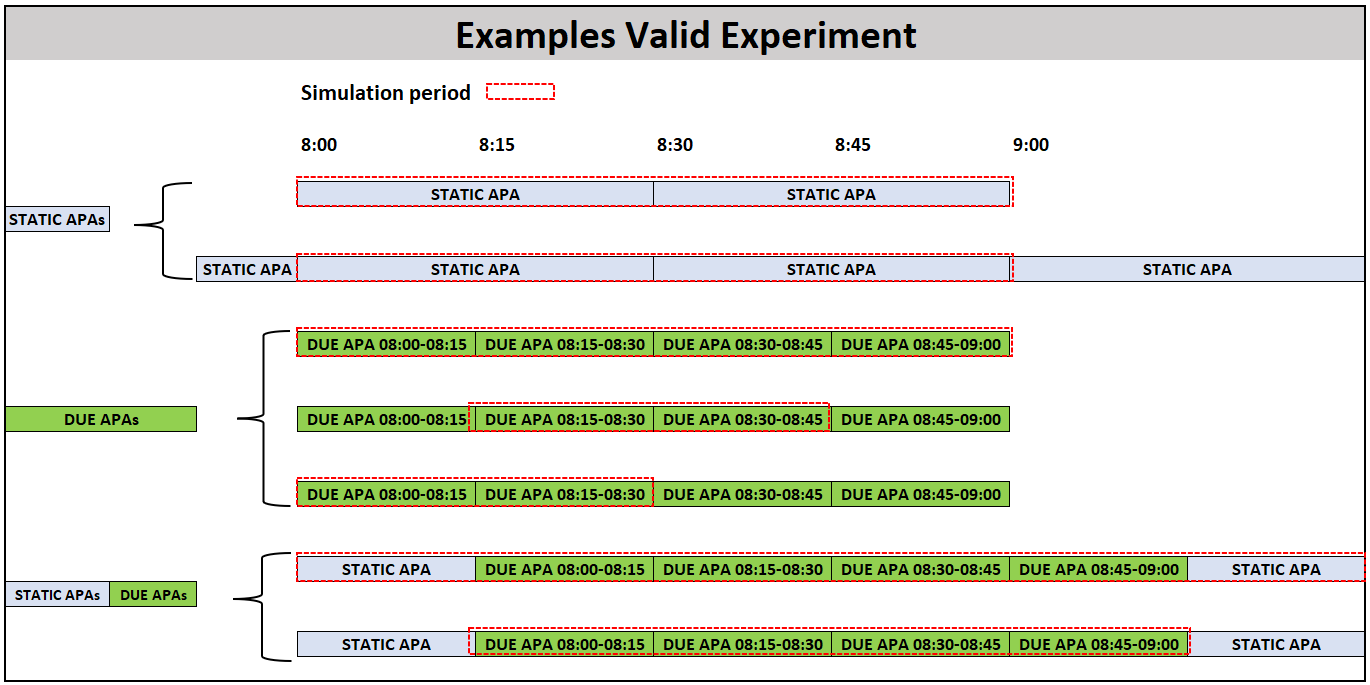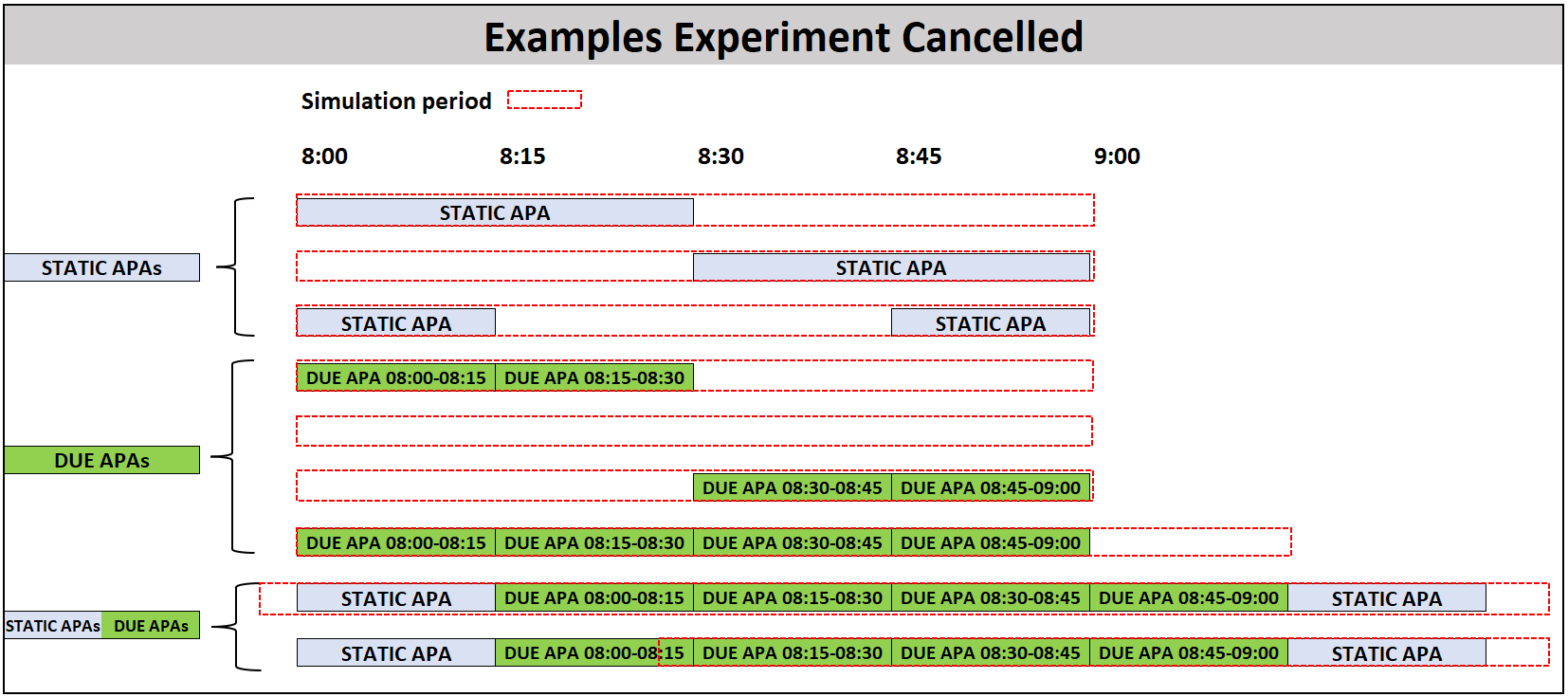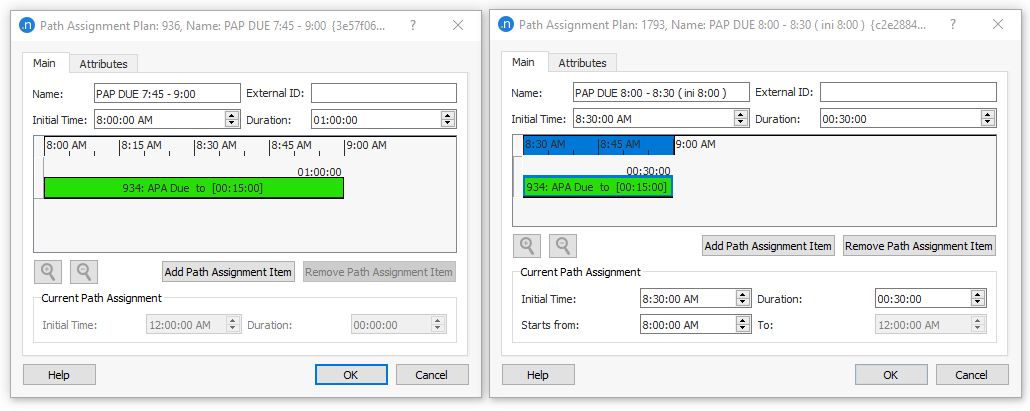Path Assignment Plan¶
A path assignment plan is a collection of path assignments and time intervals. Assembling a set of path assignments into a single path assignment plan eases the task of choosing which path assignment should be used for which time period as an input to a dynamic scenario (either SRC or DUE) or static scenario.
The Path Assignment Plan is designed to serve three purposes:
- You are running multiple macro assignments, for different periods, and you want to use those paths for different periods within a single simulation,
- You are running separate DUEs for different time periods, then you want to run a dynamic simulation either SRC or DUE that spans multiple time periods without having to run and calibrate all separate DUEs or SRCs that exactly match that period,
- You run a DUE for a long period, but then you want to run a dynamic simulation for just a portion of that period. In this case, if the duration of the dynamic path assignment file is reduced, the user can select the start time to read paths from this path assignment file.
In the image below are presented few examples of different path assignment plan configurations:

Requirement¶
The simulation period of the dynamic experiment (traffic demand duration) in which the path assignment plan is loaded as input must be included in the period of the Path Assignment Plan. If this condition is not met, then the dynamic simulation will be cancelled. An error message will be printed on the Log window similar to "Error/Zero/Negative in K-Initial/Initial/Dynamic Cost Function".
In the image below are presented few examples where the experiment will be cancelled:

Path Assignment Plan Editing¶
Use the Project menu or the Demand Data context menu to create a new Path Assignment Plan. They can also be created from their own folder context menu (Path Assignment Plans).
Path Assignment Plan Dialog¶
Open the Path Assignment Plan dialog by double-clicking on the Path Assignment Plan object in the Project window or accessing Properties in the path assignment plan's context menu.
Main Folder¶
Similarly to editing a traffic demand, editing a path assignment plan consists of setting the Initial Time and Duration for which the plan will apply, and adding the Path Assignment Items to cover the time intervals. Static and dynamic path assignments can be used.

When adding a Path Assignment Item, its number of intervals will be maintained but the interval for which it applies can be manually stretched or expanded, along with its interval lengths.
The dynamic scenario using a path assignment plan as input will, at each route choice interval, look for the corresponding time in the path assignment plan to pick up the corresponding path assignment results at that time. Therefore, intervals from the path assignment plan might be skipped if its intervals and the scenario route choice calculation intervals do not match.
Path Assignment Plan usage¶
-
The path assignment plan should be loaded on a static or dynamic simulation (SRC/DUE).
-
The path assignment plan could take as input either a single or multiple static, a single or multiple dynamic, a mix of static and dynamic path assignment files.
-
The warm-up period of the path assignment item is not considered in the path assignment plan items.
-
If the path assignment plan includes path assignment items resulted from a DUE, then this plan can be loaded to a dynamic experiment only when the path assignment plan´s period covers the entire period of the dynamic experiment (traffic demand).
-
Static path assignment files include a single set of paths per OD (no time dependent), while dynamic path assignment files include one set of paths per OD per route choice cycle, defined when the path files were generated (time dependent).
-
Static path assignment file(s) could be set to a path assignment plan and loaded as input to either a static or dynamic simulation without any time limitations. Dynamic path assignment file(s) generated from a DUE(s) (i.e. 16:00-19:00) could be set to a path assignment plan and loaded as input to a shorter period dynamic simulation (17:00-18:00). In that case, only DUE paths stored in the path assignment file from 17:00-18:00 will be applied to the dynamic simulation.
-
The path assignment plan can be loaded as input in a DUE simulation even when route choice intervals between the experiment of the input DUE path assignment item(s) and the dynamic experiment don't match. In that case, the percentages of the OD paths assigned in the dynamic experiment use proportion of the intervals of the DUE path assignment. For example, if the path assignment file generated in a DUE with a demand from 08:00 to 09:00 with 10 minutes route choice interval (in total 6 intervals) and the dynamic experiment that loads this DUE path assignment plan starts at 08:00 and finishes at 09:00 with 15 minutes interval (in total 4 intervals), then the first interval (08:00-08:15) will use 66.6% of the first interval in the path assignment (08:00-08:10) and 33.3% of the second interval in the path assignment (08:10-08:20).
-
The path assignment plan can be loaded as input in a SRC simulation even when route choice intervals between the experiment of the input DUE path assignment item(s) and the dynamic experiment don't match. In that case, the vehicles following the paths of the path assignment item will change their path set and proportions according to the interval of the path assignment item, while those vehicles following SRC will change their path set and proportions according to the SRC interval in the Dynamic Traffic Assignment in the Experiment.
-
When the a path assignment item generated for a period (i.e. 08:00-09:00) is reduced manually inside the path assignment plan (i.e. 08:30-09:00), there is an option (see image: Current Path Assignment > Initial Time: 0830, Starts from: 08:00) to select which interval (i.e. 15min) of the DUE path assignment item should be picked by the dynamic simulation (i.e. 08:30-09:00). In this example, the user chooses to start from 08:00.

Below find few examples of use cases when loading a single or multiple DUE path assignment files on a path assignment plan:
-
Consistent: Path assignment plan generated by a single or mutiple DUE(s) and dynamic simulation that loads this path assignment plan are consistent (in terms of traffic demand start time and duration).
-
Warm Up period: Vehicles will follow 100% the paths of the first set of paths either DUE or Static path assignment included in the path assignment plan, even when the warm-up period of the SRC/DUE defined is not consistent with the interval of the route choice. When the DUE apa includes a set of paths during a warm-up period then, the DUE/SRC will take the paths from the DUE apa warm-up interval, otherwise it will take the paths from the first interval.
-
Different RC Intervals: Route choice interval between DUE path assignment plan and dynamic experiment are not consistent. In this case, DUE route choice was set to 15 min and dynamic experiment route choice was set to 10 min.
-
Different RC Intervals: Route choice interval between DUE path assignment plan and dynamic experiment are not consistent. In this case, DUE route choice was set to 10 min and dynamic experiment route choice was set to 15 min.
